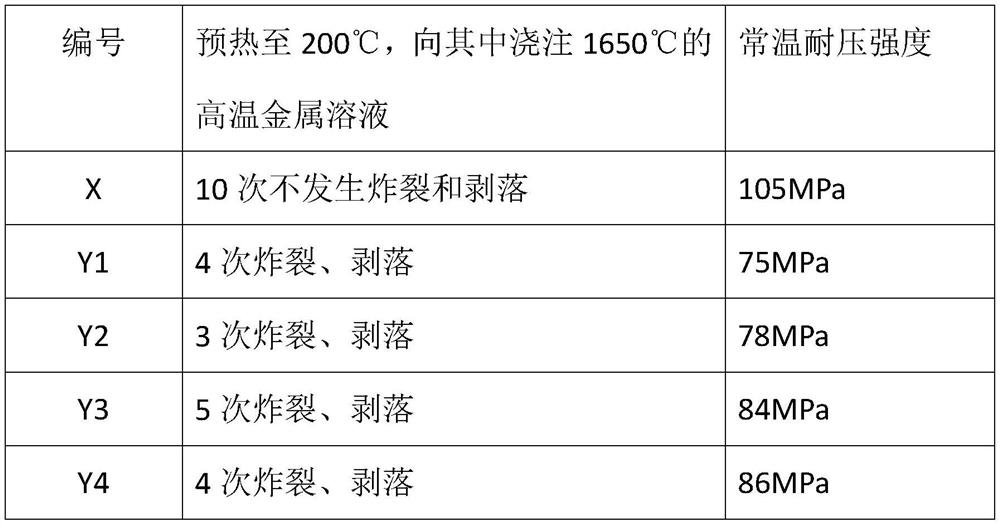High-temperature thermal shock resistant ceramic material and preparation method thereof
A technology of thermal shock resistance and ceramic materials, which is applied in the field of ceramic materials, can solve problems such as poor corrosion resistance, spalling, and poor thermal shock resistance at high temperatures, and achieve the effects of lowering temperature, increasing conversion degree, and increasing strength
- Summary
- Abstract
- Description
- Claims
- Application Information
AI Technical Summary
Problems solved by technology
Method used
Image
Examples
preparation example Construction
[0018] The invention provides a method for preparing a high-temperature thermal-shock-resistant ceramic material, which comprises the following steps: mixing ceramic powder and an organic binder at a weight ratio of 1: (0.1-0.2) to obtain ceramic feed; injecting Molding method The ceramic feed is molded, the injection pressure is 20-80MPa, and the injection temperature is 120-180°C; after the ceramic feed is molded, the obtained body is heated at a rate of 10-20°C / h to Heat at 450-550°C for 5-7 hours, and carry out debinding treatment; after degumming, heat up to 1150-1320°C at a rate of 120-180°C / h for 2-6 hours, then sinter.
[0019] Wherein, the organic binder includes organic glass, polystyrene, High density polyethylene, microcrystalline wax powder and dispersant. The dispersant is one or more of stearic acid, oleic acid, and carboxystearic acid. The ceramic powder includes, by weight, 31-53 parts of fused quartz, 25-45 parts of platy corundum powder, 20-35 parts of alu...
Embodiment 1
[0022] This embodiment provides a method for preparing a high-temperature thermal shock-resistant ceramic material, comprising the following steps:
[0023] In parts by weight, take 14 parts of the first fused silica, 16 parts of the second fused silica, 5 parts of the third fused silica, 2 parts of the fourth fused silica, 12 parts of plate-shaped corundum powder with a particle size of 0.18 to 0.1 mm, 20 parts of tabular corundum powder with a particle size of 0.045 mm, 30 parts of alumina micropowder, and 1 part of silicon nitride micropowder were put into a horizontal ceramic ball mill for ball milling for 5 hours to obtain a premix.
[0024] Add organic binder to the above premix, banbury uniformly at 150°C, and after banbury, cut into pellets with a diameter of 1-3 mm and a height of 1-5 mm to obtain ceramic feed; among them, the organic binder The weight is 10% of the total mass of the above-mentioned ceramic powder, and the weight ratio of plexiglass, polystyrene, high...
Embodiment 2
[0029] This embodiment provides a method for preparing a high-temperature thermal shock-resistant ceramic material, comprising the following steps:
[0030] In parts by weight, take 10 parts of the first fused silica, 18 parts of the second fused silica, 8 parts of the third fused silica, 3 parts of the fourth fused silica, 15 parts of plate-shaped corundum powder with a particle size of 0.18 to 0.1 mm, 18.5 parts of tabular corundum powder with a particle size of 0.045 mm, 26 parts of alumina micropowder, and 1.5 parts of silicon nitride micropowder were put into a horizontal ceramic ball mill and ball milled for 5 hours to obtain a premix.
[0031] Add an organic binder to the above premix, banbury uniformly at 180°C, and after banbury, cut into pellets with a diameter of 1-3 mm and a height of 1-5 mm to obtain ceramic feed; among them, the organic binder The weight is 15% of the total mass of the ceramic powder, and the weight ratio of organic glass, polystyrene, high-densi...
PUM
| Property | Measurement | Unit |
|---|---|---|
| particle diameter | aaaaa | aaaaa |
| particle diameter | aaaaa | aaaaa |
| particle diameter | aaaaa | aaaaa |
Abstract
Description
Claims
Application Information
 Login to View More
Login to View More - R&D
- Intellectual Property
- Life Sciences
- Materials
- Tech Scout
- Unparalleled Data Quality
- Higher Quality Content
- 60% Fewer Hallucinations
Browse by: Latest US Patents, China's latest patents, Technical Efficacy Thesaurus, Application Domain, Technology Topic, Popular Technical Reports.
© 2025 PatSnap. All rights reserved.Legal|Privacy policy|Modern Slavery Act Transparency Statement|Sitemap|About US| Contact US: help@patsnap.com

